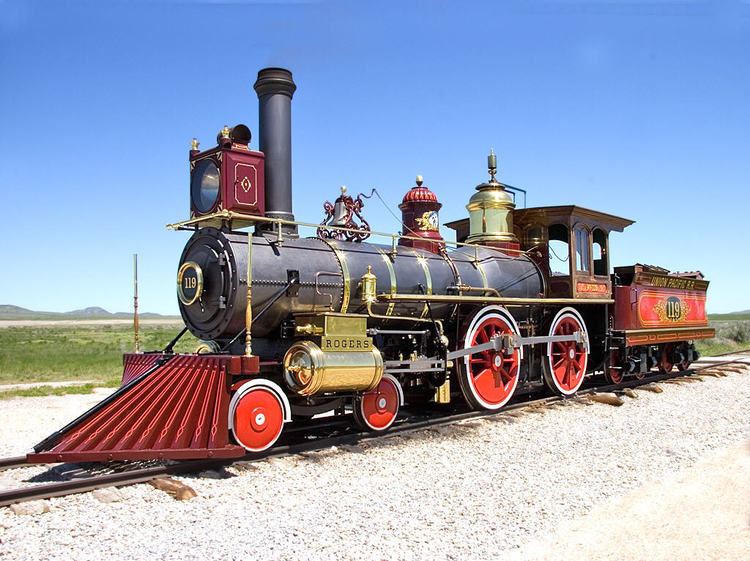Power type Steam Operators Union Pacific Railroad | Configuration 4-4-0 | |
 | ||
Builder Rogers Locomotive and Machine Works (original)
O'Connor Engineering Laboratories (replica) Build date November 1868 (original)
1979 (replica) Gauge 4 ft 8 ⁄2 in (1,435 mm) | ||
The No. 119 was a 4-4-0 steam locomotive which made history as one of the two locomotives (the other being the Jupiter) to meet at Promontory Summit during the Golden Spike ceremony commemorating the completion of the First Transcontinental Railroad.
Contents
No. 119 was built by Rogers Locomotive and Machine Works of Paterson, New Jersey in 1868 along with numbers 116, 117, 118 and 120.
This engine was scrapped in 1903, and a replica was built in 1979, 76 years after the scrapping.
Promontory Summit
No. 119 was stationed in Ogden, Utah, when a call came from Thomas C. Durant, traveling to Promontory, who needed an engine. Similar to Leland Stanford and the Jupiter, previous misfortunes allowed No. 119 to take her place in history. Durant, the vice president of the Union Pacific Railroad was traveling on the so-called Durant Special for the ceremony at Promontory. A swollen river had washed away some supports to the Devil's Gate Bridge. Durant's engineer refused to take the current engine across but did consent to nudge the lighter passenger cars across the bridge. The bridge held, the cars made it across but Durant and his entourage were left without an engine. Durant's plight was answered when No. 119 was sent from Ogden to take the Durant Special the short distance to Promontory where it came nose to nose with the Central Pacific's Jupiter.
In Andrew J. Russell's famous photograph of the Meeting of the Lines, No. 119 is seen on the right with its engineer, Sam Bradford, leaning off the pilot holding a bottle of champagne up to Jupiter engineer George Booth. Bradford and Booth would later break a bottle of champagne over the other's locomotive in celebration.
Later career
No. 119 had a similar story to the Jupiter on its entrance into history. Both engines had a similar epilogue. The 119 continued as a freight locomotive, being renumbered the 343. In 1903 it was scrapped for $1,000.
Replicas
As was the case with the Jupiter, the Union Pacific had only begun to acknowledge the 119's historical significance well after it was scrapped. In 1948, a reenactment of the Golden Spike ceremony was staged at the Chicago Railroad Fair. For this event, the Chicago, Burlington, and Quincy Railroad's locomotive number 35 was cosmetically altered to resemble the 119, and the engine's pilot met with that of the Jupiter, which was also represented by a stand-in.
In 1968, the Union Pacific sponsored the construction of the Omaha Zoo Railroad in the Henry Doorly Zoo, including a narrow gauge replica of the 119, built by Crown Metal Products.
The First Transcontinental Railroad, the National Park Service's Golden Spike site at Promontory, Utah, had exhibited representations of the 119 and Jupiter on a portion of restored trackage where the original ceremony was held. In this instance, the 119 was portrayed by the Virginia and Truckee Railroad's Dayton locomotive, (which is ironic because The Dayton was built by the Central Pacific Railroad's shops in Sacramento) and was displayed here until it and the Jupiter, which was portrayed by that railroad's Inyo locomotive, were sold to the state of Nevada in 1974.
In 1975, the National Park Service embarked on a project to reproduce the Union Pacific No. 119 and Central Pacific Jupiter exactly as they appeared in 1869. Initially, the Park Service had approached Walt Disney Studios, who had previously built two steam engines from scratch for their Disneyland park's railroad, for the project. Disney declined, but recommended Chadwell O'Connor's firm, the O'Connor Engineering Laboratories in Costa Mesa, CA, for the task. Noted railroad historian and steam engine owner Gerald M. Best served as engineering consultant to the Park Service for the project. Over 700 detailed engineering drawings were recreated, based almost entirely on the photographs taken of the engines during the ceremony, as the original drawings had not been preserved. Disney animator and steam engine owner Ward Kimball did color matching and original artwork for the Jupiter and No. 119.
Media
In 2015, a Lego model depicting the No. 119 locomotive was submitted to the Lego Ideas website.
In "The Communication Deterioration" episode of The Big Bang Theory, Sheldon shows a photo of the locomotive to Penny.
